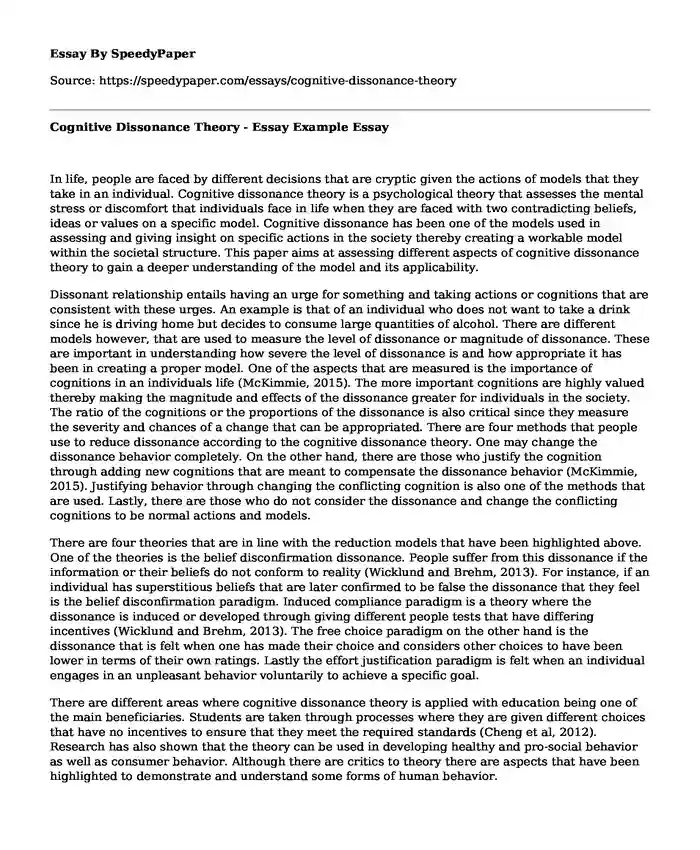
| Type of paper: | Essay |
| Categories: | Psychology |
| Pages: | 3 |
| Wordcount: | 682 words |
In life, people are faced by different decisions that are cryptic given the actions of models that they take in an individual. Cognitive dissonance theory is a psychological theory that assesses the mental stress or discomfort that individuals face in life when they are faced with two contradicting beliefs, ideas or values on a specific model. Cognitive dissonance has been one of the models used in assessing and giving insight on specific actions in the society thereby creating a workable model within the societal structure. This paper aims at assessing different aspects of cognitive dissonance theory to gain a deeper understanding of the model and its applicability.
Dissonant relationship entails having an urge for something and taking actions or cognitions that are consistent with these urges. An example is that of an individual who does not want to take a drink since he is driving home but decides to consume large quantities of alcohol. There are different models however, that are used to measure the level of dissonance or magnitude of dissonance. These are important in understanding how severe the level of dissonance is and how appropriate it has been in creating a proper model. One of the aspects that are measured is the importance of cognitions in an individuals life (McKimmie, 2015). The more important cognitions are highly valued thereby making the magnitude and effects of the dissonance greater for individuals in the society. The ratio of the cognitions or the proportions of the dissonance is also critical since they measure the severity and chances of a change that can be appropriated. There are four methods that people use to reduce dissonance according to the cognitive dissonance theory. One may change the dissonance behavior completely. On the other hand, there are those who justify the cognition through adding new cognitions that are meant to compensate the dissonance behavior (McKimmie, 2015). Justifying behavior through changing the conflicting cognition is also one of the methods that are used. Lastly, there are those who do not consider the dissonance and change the conflicting cognitions to be normal actions and models.
There are four theories that are in line with the reduction models that have been highlighted above. One of the theories is the belief disconfirmation dissonance. People suffer from this dissonance if the information or their beliefs do not conform to reality (Wicklund and Brehm, 2013). For instance, if an individual has superstitious beliefs that are later confirmed to be false the dissonance that they feel is the belief disconfirmation paradigm. Induced compliance paradigm is a theory where the dissonance is induced or developed through giving different people tests that have differing incentives (Wicklund and Brehm, 2013). The free choice paradigm on the other hand is the dissonance that is felt when one has made their choice and considers other choices to have been lower in terms of their own ratings. Lastly the effort justification paradigm is felt when an individual engages in an unpleasant behavior voluntarily to achieve a specific goal.
There are different areas where cognitive dissonance theory is applied with education being one of the main beneficiaries. Students are taken through processes where they are given different choices that have no incentives to ensure that they meet the required standards (Cheng et al, 2012). Research has also shown that the theory can be used in developing healthy and pro-social behavior as well as consumer behavior. Although there are critics to theory there are aspects that have been highlighted to demonstrate and understand some forms of human behavior.
In conclusion, cognitive dissonance highlights the conflicting cognitions and models that individuals may have in a society. In making a deeper and more critical analysis of these models it is easier to gain a deeper understanding of human behavior and actions in the society.
References
Cheng, P. Y., & Hsu, P. K. (2012). Cognitive dissonance theory and the certification examination: The role of responsibility. Social Behavior and Personality: an international journal, 40(7), 1103-1111.
McKimmie, B. M. (2015). Cognitive Dissonance in Groups. Social and Personality Psychology Compass, 9(4), 202-212.
Wicklund, R. A., & Brehm, J. W. (2013). Perspectives on cognitive dissonance. Psychology Press.
Cite this page
Cognitive Dissonance Theory - Essay Example. (2019, Sep 26). Retrieved from https://speedypaper.net/essays/cognitive-dissonance-theory
Request Removal
If you are the original author of this essay and no longer wish to have it published on the SpeedyPaper website, please click below to request its removal:
- Bad Parenting In The Glass Castle - Essay Sample to Check
- The Miller's Tale Rewritten as a Modern Essay Example
- Financial Field Essay Example
- How Americans View on Muslims: Essay Example
- BodyArmour Drink Strengths and Weaknesses. Free Essay.
- Essay Example on Change of Common Law Approach to Mitigation
- Paper Example. Henry Roberto Cuellar
Popular categories




